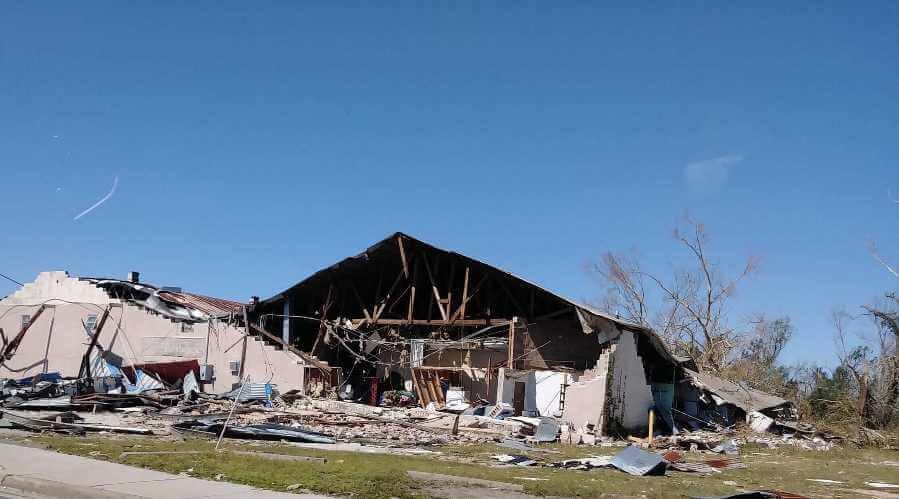In the face of catastrophic events, scenes of property destruction give the first indications of economic loss for businesses. Interruptions to the companies’ ability to produce goods and services, however, actually have a much greater effect on their bottom line.
In fact, business interruption losses on average exceed property damage losses by over 900%, according to new Ohio State University research co-authored by Noah Dormady, associate professor in the John Glenn College of Public Affairs.
One solution: resilience.
Dormady and his colleagues ran large-area surveys of firms affected by Superstorm Sandy and Hurricane Harvey and found that for every dollar spent on resilience, firms avoided an average of $4.57 in business interruption losses.
“This is important because it demonstrates that businesses can see a real return from spending on their own plant and labor force,” said Dormady, who also is an affiliated faculty member of the Sustainability Institute at Ohio State. “It shows that even in the worst disasters, rather than only parking those investments in Wall Street through insurance, businesses can find cost-effective ways to reduce disaster losses by supporting Main Street here at home — by spending wisely on their own workforce and physical plant.”
The study, published recently in the International Journal of Production Economics, provides the first empirical assessment of economic resilience metrics that businesses can use to prioritize resilience expenditures to maintain business continuity and stability.
In contrast to advance planning and mitigation strategies to avoid property damage, firms can use a variety of resilience tactics after the disaster strikes to reduce business interruption losses more cost effectively, the study found. The research provides insight into the cost-effectiveness of nearly a dozen classes of resilience tactics such as relocation, conservation of inputs, isolating remaining resources, pooling of resources and technological change.
“The key to economic resilience of the firm is identifying the most impactful and cost-effective set of tactics that can be used for each type of input and infrastructure disruption. The era of ‘resilience’ as an amorphous buzzword is over. Resilience can now be measured, and it can be quantified,” Dormady said. “Businesses can use that to their advantage to make well-informed data-driven decisions. And government can use that information to make impactful and targeted investments.
“Oftentimes, we hear a lot about resilience from the standpoint of government playing a big role in investing in costly and capital-intensive mitigation projects or incentivizing insurance,” said Dormady. “But when you take a deeper look and account for how individual businesses adapt and respond to disruptions, it turns out that much of the economic losses can be muted by actions taken at the level of the individual firm.”
Dormady and his colleagues used two of the most devastating U.S. natural disasters to demonstrate the metrics they developed for the cost-effectiveness of economic resilience tactics. They surveyed firms affected by Superstorm Sandy, which made landfall in New Jersey in 2012, and Hurricane Harvey, which hit Texas in 2017. Analyzing the responses from firms that used resilience tactics, they identified the firms’ actual losses and estimated what their sales revenue would have been had they not used resilience tactics. They then calculated the costs of resilience tactics that the firms implemented and the resulting losses that were avoided.
The survey clearly illustrated how business interruption losses exceed property damage losses among firms. Among the survey results, property damage was $69 million and $52 million for the Sandy and Harvey samples, respectively. Total sample business interruption loss was $111 million and over $1 billion for Sandy and Harvey, respectively.
Significantly, the researchers found that in all, the firms’ resilience expenditures, totaling $18.5 million, resulted in preventing $84.4 million in losses.
A variety of factors, including labor and infrastructure disruptions, influenced just how effective and cost-effective each class of tactic was. Some firms used tactics that avoided no losses, while other tactics avoided as much as 74% of maximum potential losses.
“After a disaster strikes, a lot of small and mid-sized businesses spin their proverbial wheels on actions that they think will help them stave off losses, and they may end up wasting a lot of money, time and resources,” said Blain Morin, an Ohio State public policy and management doctoral candidate and one of the study’s co-authors. “What individual businesses, government and insurers need is resilience actions that are based on actual data-driven analyses — absent from today’s most prominent resilience planning platforms.”
“Federal and state agencies are always searching for a more effective way to help small and mid-sized businesses in disasters.” said Dormady. “Our paper provides some evidence that there is not a simple one-size-fits-all public sector response that supports all businesses. Rather, businesses can make well-informed, data-driven responses that take into consideration the specific input characteristics, infrastructure and supply-chain disruptions that most directly impact them.”
Dormady conducted the research with Morin; Adam Rose, a professor at the Price School of Public Policy at the University of Southern California; and Alfredo Roa-Henriquez, a Glenn College PhD alumnus who is now an assistant professor at the College of Business at North Dakota State University.
This research received funding support from the Critical Infrastructure Resilience Institute at the University of Illinois, Urbana-Champaign, and the U.S. Department of Homeland Security Office of Science and Technology.


